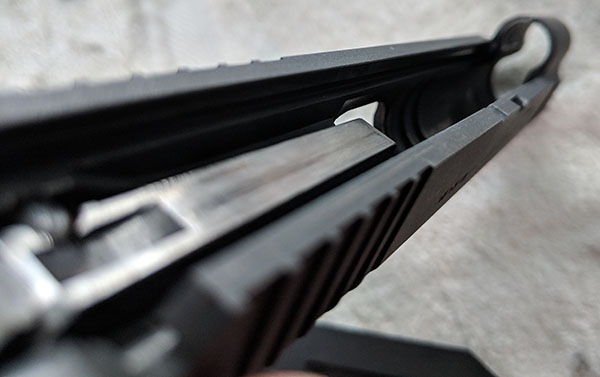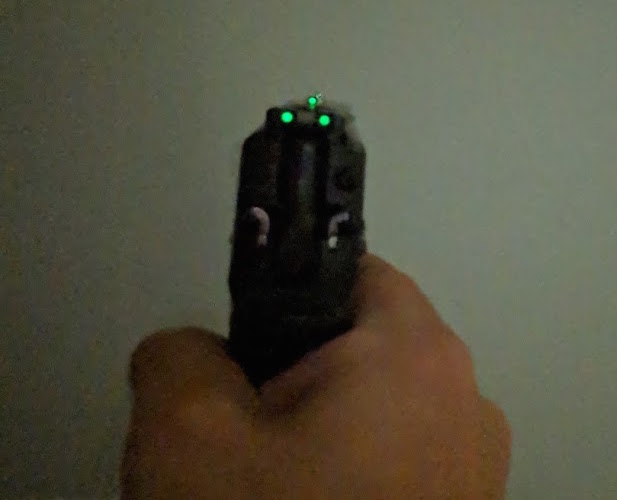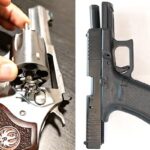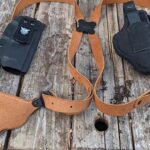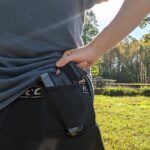If you’ve purchased a pistol from a licensed dealer, then your handgun should have come with a cable lock. However, a private sale may or may not have come with any kind of lock. Regardless, using a pistol cable lock is not necessarily intuitive. Especially since the process differs between revolvers and automatics.
When using a pistol cable lock with an automatic, you have two options. In order to use a pistol cable lock run the cable lock through the open slide and run the cable down through the magazine well. Alternatively, you can run the cable lock through the barrel and out the muzzle. Both of these options prevent the slide from returning to the forward position.
However, using a cable lock with a revolver is a bit different but you still have two options.First, run the cable through the top chamber on the left side of the revolver. Next, run the cable back through the lower chamber on the left side before locking. Alternatively, you can run the cable through the barrel of the revolver to prevent the chambers from lining up with the barrel.
Table of Contents
Using A Cable Lock On An Automatic
The purpose of a cable lock is to prevent the operation of the handgun when not in use. Therefore, the best way to accomplish this, short of removing parts of the weapon, is to stop the action. Below, I’m going to illustrate the process for using a cable lock with your automatic.
1. Unload The Handgun And Lock The Slide
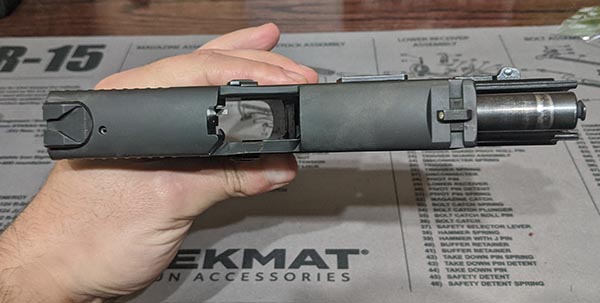
Before you place the cable lock on your automatic, you’ll need to unload (clear) the firearm. Start by ejecting the magazine. Next, pull the slide back to eject any round in the chamber. You should do this more than once. Finally, lock the slide in the rearward position and inspect the chamber.
Some pistols, like my Walther PK380, require an empty magazine to be inserted for the slide to lock rearward. In this instance, eject your magazine and clear the chamber using the process above. However, next you’ll need to insert an empty magazine into the gun then pull back on the slide to get it to lock backward. Finally, eject the empty magazine and visually inspect the chamber before moving onto the next step.
2. Unlock the Cable And Insert Into The Handgun
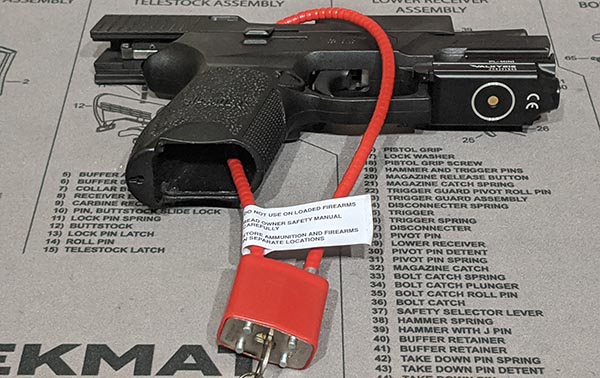
After clearing the firearm, it’s time to put the cable lock into place. To prevent the loading of rounds into the handgun, you have to options for cable lock placement. First, you can run the cable down into the open action and through the bottom of the magazine well. Do NOT try to feed the end with the lock through the action.
Once the cable is in place, insert the loose end into the lock. Twist the key to engage the locking mechanism, and remove the key. At this point, even if you release the slide it should not be allowed to return to the forward position.
3. Alternative Cable Lock Location
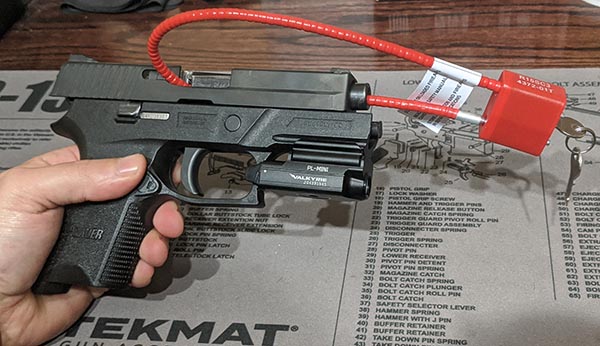
Another method of using a cable lock with an automatic is utilizing the barrel. Instead of running the cable through the magazine well, thread the small end of the cable into the barrel and out the muzzle. Although, you could thread the cable into the muzzle and out the action as well. Afterwards, insert the cable into the lock and engage. Above is an illustration of this method.
I generally only use my cable locks when heading to the shooting range with multiple guns. Otherwise, I lock them up in one of my safes for storage. I prefer not to run the cable through the bore, as this could damage the rifling. Additionally, any cable lock without an outer coating could damage the feed ramp.
4. Storing Your Automatic With A Cable Lock
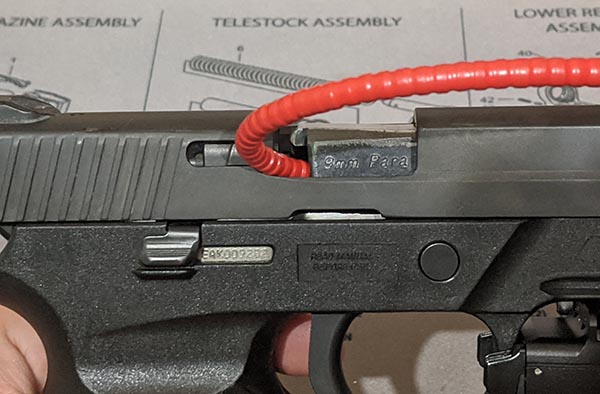
If you’ll be storing your firearm with a cable lock, I recommend that you leave the slide locked. Leaving the recoil spring compressed should not impact elasticity. For more on this read this article about ammo rotation and magazine springs. However, you could exercise the spring periodically to ensure the slide does not get stuck and the handgun is in working order.
Another reason to leave the spring compressed while using a cable lock is to protect the slide. Allowing the slide to rest against the cable could cause damage to the guns finish. If your cable does not have a protective coating it could also damage the ejection or loading port (example above).
Using A Cable Lock With A Revolver
Because revolvers have multiple chambers, the process of using a cable lock is a bit different from an automatic. However, the principles are the same. The purpose of a cable lock is to render the gun inoperable. Below are instructions on the two methods for using a cable lock with a revolver.
1. Unload the Revolver
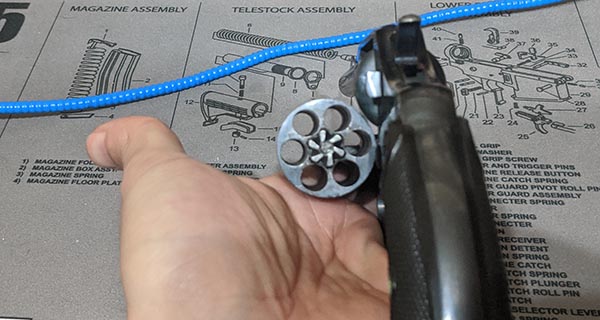
Prior to placing the cable lock on your revolver, you need to ensure the firearm is not loaded. To clear your revolver press the cylinder release button, which is found on the left side of the gun between the trigger and grip. Next, tilt the gun rearward and simultaneously press the ejector rod. Visually inspect each chamber to ensure they are not loaded. Sometimes you’ll need to give the revolver a little shake to make sure the rounds are ejected.
Once you have unloaded ALL the chambers, do not push the wheel back into the revolver. Ensure that the hammer is down for any revolver with an exposed hammer.
2. Placing The Cable Lock On A Revolver
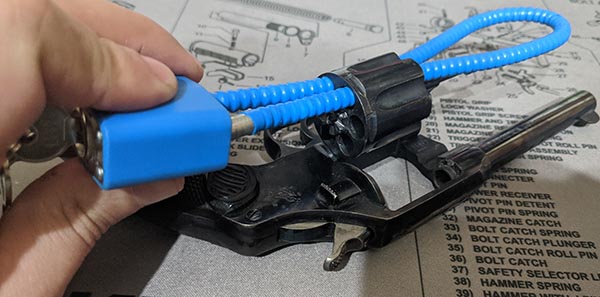
The cylinder on a revolver can rotate clockwise or counter-clockwise (when observed from the rear of the gun) depending on make/model of revolver. It’s important to note which way the wheel on your revolver rotates before installing your cable lock.
If the wheel on your revolver rotates clockwise (as observed from the rear of the gun) then you’ll position the lock on the left hand side. However, if the wheel rotates counter-clockwise then you’ll place the lock on the right hand side.
Next, thread the cable end of the lock through the topmost exposed cylinder. Afterwards, thread the cable end back through the bottom cylinder. This should prevent the cylinder from rotating when the trigger is pulled or the hammer is pulled back.
3. Another Method For Placing Cable Lock On A Revolver
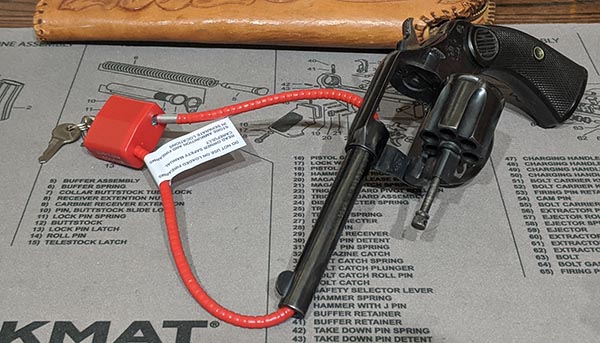
Although the above method is generally accepted, it does leave room for error. Alternatively, you could run a cable lock through the barrel barrel, similar to the method used on an automatic. Using a cable lock this way will prevent the wheel from seating and lining up the chamber with the barrel.
Trigger Lock vs. Cable Lock: Which Is Better?
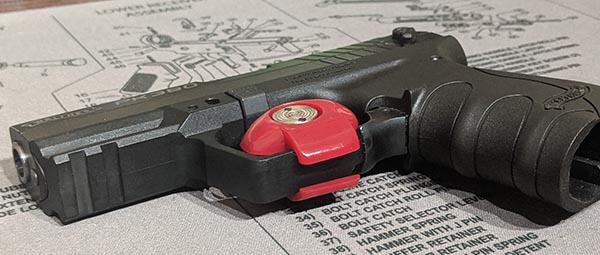
Trigger locks are usually sufficient from preventing a child from accidentally operating a handgun when used properly. However, I’ve heard of too many horror stories where the trigger was still able to be manipulated even with a trigger lock. Pictured above is a free trigger lock that came with one of my guns. Anyone who uses a trigger lock should be familiar with the points of failure associated with these types of locks.
When it comes to which method is better, cable locks or trigger locks, I’m more confident in a cable lock to secure a firearm. However, neither are particularly strong, and anyone with a desire to remove them will find a way. Anyone with children understands that they are capable of extraordinary feats if left unsupervised. Each method is meant to secure a portion of the pistol, either the trigger or the action. But neither method restricts access to the firearm itself.
Cable Locks vs. Handgun Safes
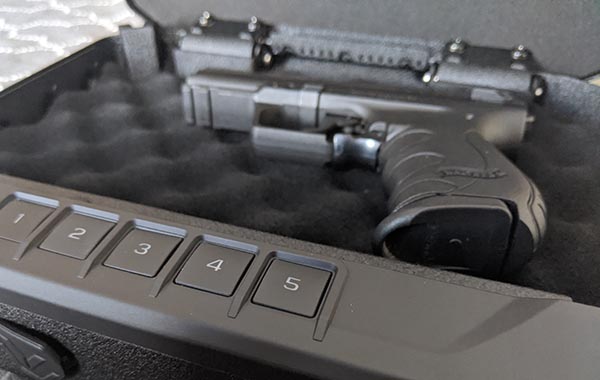
This brings us to the final section on which method of securing your pistol reigns supreme. If you really want to prevent your firearm from being handled, then the best method for securing your firearm is a safe. Not only will this prevent small children from tampering with your handgun if they get too curios, it also is much more functional.
With a pistol safe, you can store and access your firearm, and within seconds it is ready to use. A good quality safe is only going to run you a couple hundred dollars, particularly if you only have one pistol. I recommend the Vaultek VE Series Safes, and coincidentally so does my locksmith friend. You can read more about this pistol safe here.
Parting Shots
Now that you’ve learned how to use a cable lock, it’s time you decide if that is enough security. If you live in certain states, you may actually be required by law to use a handgun safe for storing your firearms. Regardless, you may at some point be required to use a cable lock during the transport of your firearms to the range. Do you have any comments about using a cable lock with an automatic or revolver? Leave a comment below.

